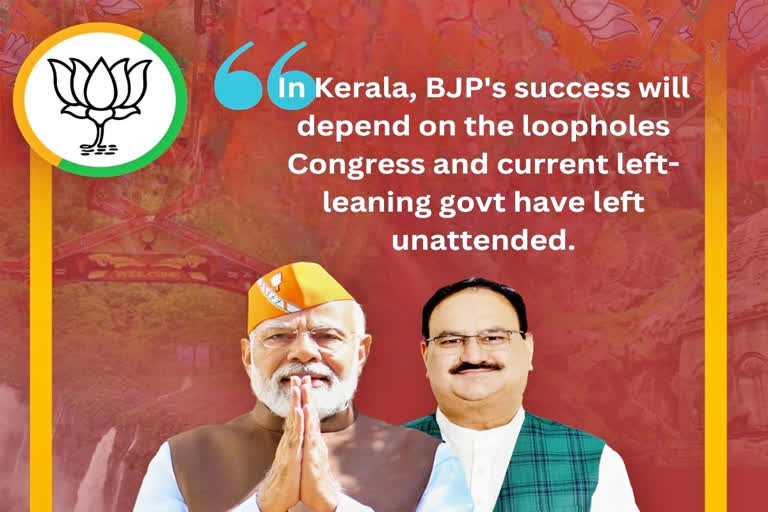Hyderabad: BJP’s success story in the northeastern states is a classic example of how efficiently the saffron party carries out the politics of 'playing along', adjusting its 'core beliefs' to fit the regional prism. One of the instances that substantiates this argument is when PM Narendra Modi chanted slogans of Nagalim, which Nagas refer to as a cause for Greater Nagaland, in Kisama prior to the 2014 general elections.
For the BJP, painting the entire region in saffron has not been an overnight journey. It has been primarily an effort of the RSS, the saffron party's ideological parent, that worked hard for decades to pave the road for BJP's electoral politics and its eventual success in the region, evident by the fact that the organisation's units (shakhas) in the region grew to around 6,000 from a few hundred.
BJP’s ambition to make a smooth entry into the region was a prelude to RSS' effort in the area where people had experienced extreme estrangement from the Congress. For the Congress, the northeast has always been an insurgency-hit zone that had to be handled sternly in order to contain the brewing sentiments of separatism within this region. The most recent elections in three states have left the party in the region on the verge of extinction because they were unable to see beyond the conflict and gradually lost control.
There was apparently no meaning for electoral politics in the majority of the northeastern states because insurgent groups would call for a boycott, leaving the turf open for the Congress. Evidently, this has led to the Congress party becoming complacent by the day. Curbing insurgency and bringing peace, the Congress' plank for decades, lost its relevance as the region desperately needed development.
As fatigue crept in, people realised that there was more to mainstream politics in the northeast than conflict. BJP sensed the desperation and presented itself as the party that wanted to change the northeast for the good while ensuring local values and sentiments do find space in the hardcore modus operandi of the Hindu nationalist party. BJP shook hands with the regional parties and made inroads in the northeast including in Nagaland and Meghalaya, the two Christian-majority states.
The party made sure that while elsewhere it continued to dictate matters, in the northeast they had (or at least pretend) to be inclusive. BJP also had to deal with the call for greater Nagaland and here too, it tuned down its approach to a perfect decibel to form the government. Taking advantage of the regional cause to appeal to public sentiment, PM Modi, in December 2014 chanted slogans of ‘Nagalim’ during the Hornbill festival in Kisama.
Choosing the Hornbill festival was quite a strategic move because it has a representation of all the ethnic groups of Nagaland. The BJP's electoral failure in 2013 came as a wake-up call, and the party made the decision to align itself with regional parties and try things that had not been tried before. It happened after BJP lost elections in Nagaland, even 8 of 11 candidates lost their security deposits. Similarly in Meghalaya, 13 candidates witnessed a similar result.
After PM Modi took office in 2014, the northeast was an area that was closely watched, and the goal was to form a BJP government in the states of the region to dispel the perception that the party is only for Hindus. Alphons Kannanthanam, a former union minister in the BJP and Christain from Kerala, was appointed election in-charge prior to the 2018 elections in an effort to influence the Christians of the region.
He announced the renovation of churches right away as a show of goodwill to his community, which worked as an ice-breaking step. In spite of the fact that the Congress party won the most seats in the legislature in the 2018 elections, voters were still looking for another party to support because the Congress party never valued the region's importance in the election process.
To engage with people in the northeast regions, the BJP sent almost all major faces. Modi himself visited the states more than 50 times. As many as 70 BJP ministers made more than 400 visits to the region. BJP’s alliance with the regional parties not only paid off in the long run but also helped them consolidate their base against Congress votes.
Unlike the northeast, there is no coalition between the Congress party and the left in Kerala, despite the fact that the partnership has the potential to produce more beneficial results for them than other states, given their hold and acceptability among the people. BJP was completely wiped out of the state in the last assembly elections but still holds the fort through its RSS units which are spread across the length and breadth of the region.
The Communist-ruled state of Kerala is currently in the spotlight, and if the BJP gets control of it anytime in the future, the party will appear incredibly inclusive for which they are actually striving. In addition to their traditional strategies, BJP's success will depend on the loopholes Congress and the current left-leaning government have left unattended.



